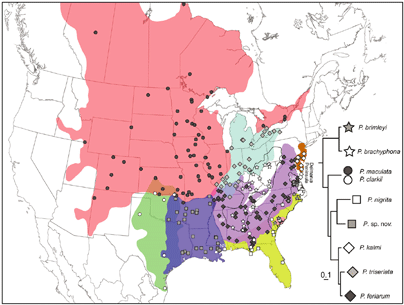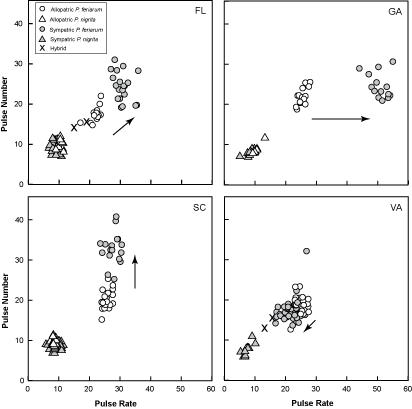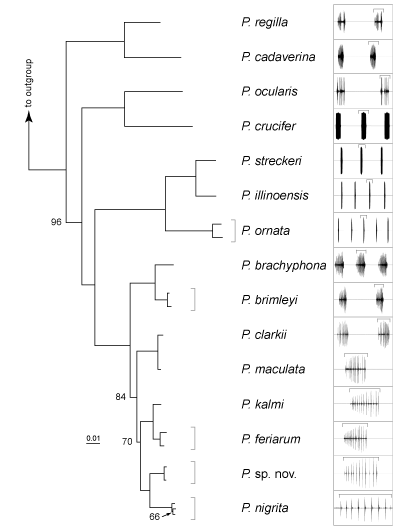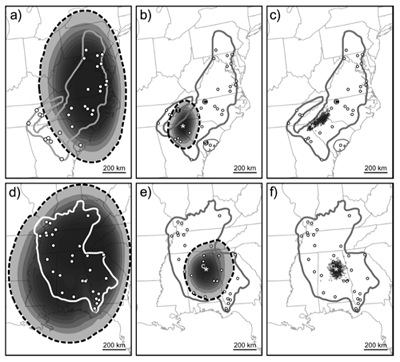
| Home | Research | Publications | People | Links | Contact Us | Prospective Students |
 |
Our research concentrates primarily on evolution in amphibians, however, students interested in working on other taxa, such as reptiles or insects, that focus on general speciation questions are also encouraged to apply to the lab. Much of our work centers on frogs, which are ideal organisms for studying speciation for several reasons. First, premating isolation is easy to quantify, in terms of male acoustic signals and female preferences for these signals. Second, postmating isolation is straightforward to quantify, through natural or in vitro lab hybridization experiments. Third, the large population sizes of most species permit field collection of the large sample sizes necessary for statistical power in broad- and fine-scale genetic studies. Our current fieldwork on amphibians involves projects in both North America and South America. In addition, we collaborate on theoretical and methodological projects with Alan Lemmon's Lab (Department of Scientific Computing). We have found that integrating field-based projects with the development of new methods for The figure to the right is an example of the scale of fieldwork we conduct in our lab. The frog genus Pseudacris covers a large portion of North America. As a result, fieldwork for this phylogeography project (Lemmon et al. 2007a, 2007b) involved months of intense sampling across the geographic ranges of different species during the early spring breeding season. Other types of fieldwork that members of the lab may conduct include monitoring local populations in the Apalachicola National Forest, or studying tropical species in Ecuador. One of our current major research directions is marker development using new genomic technologies. Clearly, biologists urgently need large numbers of orthologous nuclear markers that are informative at the appropriate level for phylogenetic and phylogeographic studies in non-model systems. We are working intensively on developing different approaches to genome reduction in order to target certain portions of the genome that are useful for particular research questions. These strategies should be broadly applicable to any system. ***Below is just a sampling of the many projects currently being conducted in the lab. Our work is highly integrative, drawing from fields such as genetics, genomics, behavior, neurobiology, physiology, GIS modeling, geology, and beyond. For more information about current projects, contact us. Theoretical and Methodological Projects Research Facilities at Florida State University
North American Projects (photographs of fieldwork) Speciation-in-action driven by reinforcement in chorus frog contact zones In the southeastern United States, two chorus frog species (Pseudacris feriarum and P. nigrita) have come into geographic contact and undergone reproductive character displacement through reinforcement of mating signals and preferences. Interestingly, different signal traits have displaced in different sympatric populations of Pseudacris feriarum, likely as a result of interactions with different assemblages of heterospecific taxa. A possible consequence of this outcome is that populations within sympatry may not recognize each other as members of the same species. This exciting finding suggests that an indirect effect of reinforcement could potentially be a cascade of additional speciation events within displacing taxa. Research in the near future will investigate this ongoing process in detail using genetic and behavioral approaches. Relevant Papers:
Investigating the evolution of acoustic signals across frog clades The behavioral character that is most important for maintaining species boundaries in nearly all frogs is the acoustic signal. Despite the known importance of calls in frogs, the evolution of species-specific acoustic differences is poorly understood. To study this process, I examined patterns of acoustic signal evolution across the chorus frog clade using comparative methods approaches. Interestingly, different traits within the acoustic signal evolve independently of each other, with some diversifying early in radiation of this clade and others differentiating later. Moreover, some traits are evolving under a neutral model, whereas others show evidence for selection. In a second part of this study, I found a pattern of acoustic niche partitioning, where sympatric frogs exhibit greater signal differences than allopatric frogs. This pattern may result from signal assortment (where frogs only become sympatric if their signals are already distinct) or reproductive character displacement. In further work on acoustic signal evolution, I hope to investigate additional frog clades with structurally similar signals, to test predictions generated from this study and to determine whether the sequence of signal trait evolution is consistent among distantly-related clades. E. Moriarty Lemmon, M. Gridi-Papp, D. Cannatella. In prep. Evolution of acoustic signals in chorus frogs (Pseudacris): patterns of selection and sequence of trait evolution. E. Moriarty Lemmon, A. R. Lemmon, M. Gridi-Papp, D. Cannatella. In prep. A phylogenetically-corrected comparative approach to studying resource partitioning, with an test case of acoustic niche partitioning in frogs.
South American Projects (photographs of fieldwork) We are just initiating research in South America in collaboration with Santiago Ron from the Pontifical Universidad Católica del Ecuador. Graduate students in the Moriarty Lemmon Lab are encouraged to develop research systems in South America, with a concentration in Ecuador, the country with the highest amphibian diversity in the world. Suggestions for frog clades in Ecuador that need substantial phylogenetic work include Dendropsophus, Hypsiboas, Pristimantis, and Centrollenidae. Clades that might be particularly interesting for behavioral studies include Dendropsophus and Dendrobatidae.
Theoretical and Methodological Projects Developing improved methods for phylogeography Current phylogeographic methods are limited in their utility for testing a priori hypotheses in a statistically rigorous manner. In addition, these methods cannot easily incorporate external non-genetic data that are important for informing analyses, such as ecological niche models and landscape data. To address these issues, Alan Lemmon and I developed a maximum likelihood-based phylogeography method for testing hypotheses within a statistical framework. We are currently extending the method into a Bayesian framework, which will allow researchers to incorporate environmental data directly into analyses. Relevant Papers:
Development of broad-scale genomic resources for amphibians Phylogenetic and phylogeographic studies of amphibians are limited in the number and diversity of genes that they employ, due to the difficulty of rapidly identifying and screening markers of the appropriate rate of evolution from across the genome. As a result of this problem, large multi-locus and phylogenomic studies are currently impractical. To resolve this problem, Alan Lemmon (FSU—Scientific Computing), Erica Rosenblum (University of Idaho), and I are collaborating on a project that employs new genomic approaches and bioinformatics to develop significant genomic resources for amphibian genetics. Our project will facilitate research in this field by providing a large list markers, organized by rate of molecular evolution, from which researchers can select appropriate markers for their target clade. This targeted phylogenetics approach will help researchers maximize the amount of genetic information per unit gene for the clade of interest and thus optimize their financial investment. Moreover, the dataset generated from this study will be a resource for genome-wide studies of molecular evolution and levels of selection on genes in amphibians.
These are various links to recent newspaper articles announcing our description of a new frog species, the Cajun chorus frog (Pseudacris fouquettei) PDF. Warning: most articles contained at least one major factual error so do not believe everything you read. |
 analyzing data is a very fruitful direction of research.
analyzing data is a very fruitful direction of research. 


